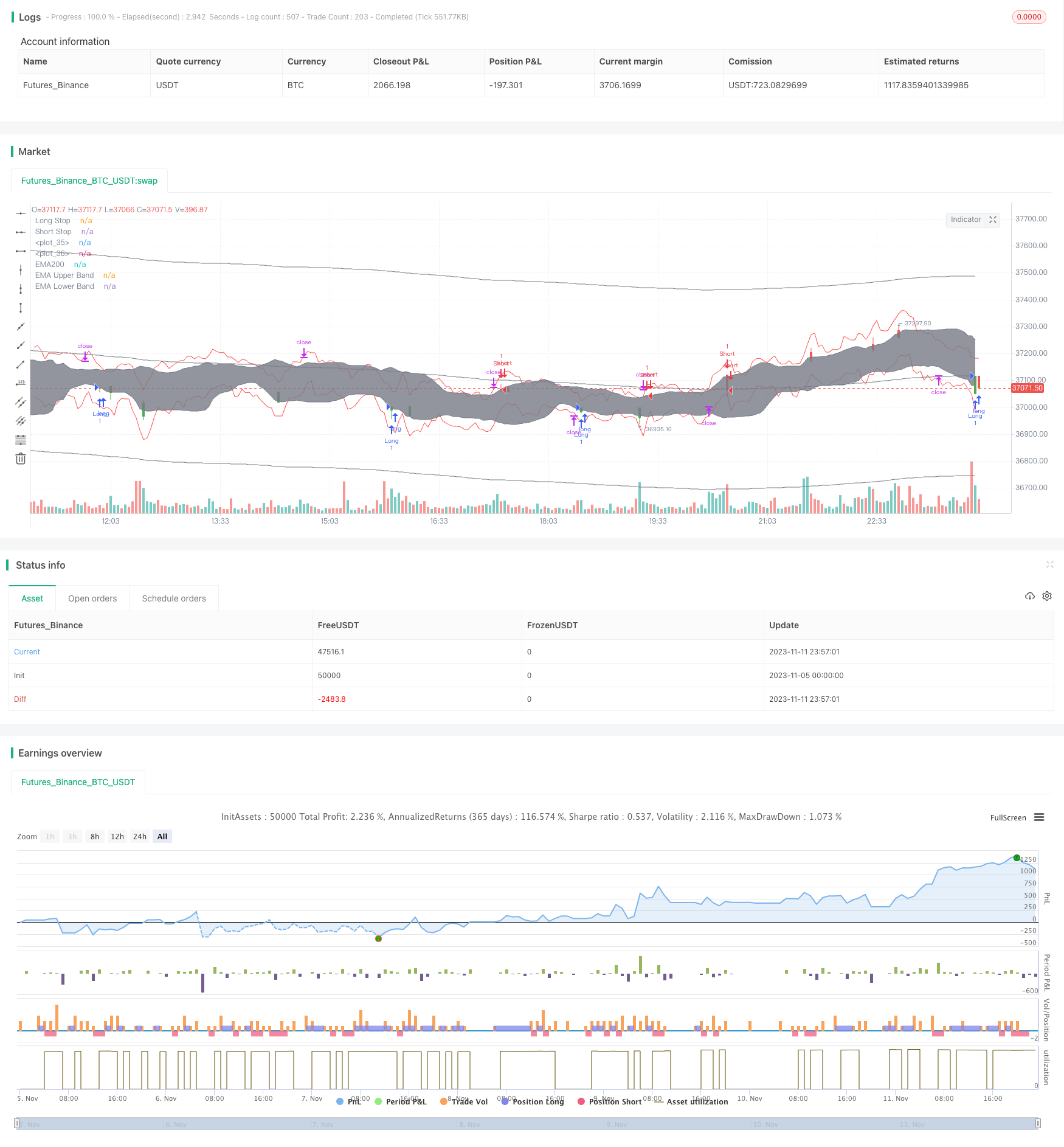
概述
该策略基于用户选择的EMA和定义的百分比通道。当价格低于上轨时,策略做多;当价格高于下轨时,策略做空。如果价格开始趋势交易并突破通道,则平仓所有头寸,以防止损失。
对于趋势性市场,建议使用配套的“EMA百分比通道与布林带趋势交易策略”。
原理
计算200周期的EMA作为基准EMA。
根据用户设置的百分比,计算上下轨: 上轨 = EMA * (1 + 百分比) 下轨 = EMA * (1 - 百分比)
计算20周期的布林带,描绘通道范围。
当收盘价由下向上突破布林带下轨时,做多;当收盘价由上向下突破布林带上轨时,做空。
使用ATR计算止损位,避免过大亏损。
如果价格超出设置的百分比通道范围,则平仓所有头寸,防止进一步损失。
优势
使用EMA作为基准,可以更好地捕捉趋势转换点。
百分比通道设定合理的交易范围,避免过于频繁交易。
布林带提供支撑阻力位,辅助判断进场时机。
使用ATR trailing stopdynamically设置止损,有效控制单笔交易风险。
价格超出通道则全部平仓,可快速控制损失。
可自定义的参数设置灵活,可针对不同市场调整。
风险
如果百分比通道范围过宽,可能错过趋势或防止亏损不及时。
如果百分比通道范围过窄,可能过于频繁交易,增加交易成本。
布林带参数设置不当也可能导致错过交易机会。
停损点设定过于宽松可能导致单笔亏损过大。
需要适当优化参数以找到最佳交易范围。
优化方向
测试不同的EMA周期参数,找到最适合的均线周期。
优化百分比通道参数,寻找最佳通道范围。
调整布林带周期参数,优化捕捉波动的效果。
调整ATR周期和倍数,进一步优化止损策略。
测试仅做多上方或做空下方的条件,看是否能提高胜率。
结合趋势指标,判断是否需要提前平仓。
总结
该策略综合利用均线、通道、波动率等多种指标的优势,实现了较为稳定的区间交易策略。关键是找到最适合特定市场的各项参数设置,实现风险和收益的平衡。未来可继续优化参数及策略规则,或与趋势交易策略组合使用。
/*backtest
start: 2023-11-05 00:00:00
end: 2023-11-12 00:00:00
period: 3m
basePeriod: 1m
exchanges: [{"eid":"Futures_Binance","currency":"BTC_USDT"}]
*/
//@version=4
strategy(title="[mdeacey] EMA% Channel + BB Range Strategy", shorttitle="[mdeacey] EMA% Channel + BB Range Strategy", overlay=true)
//EMA 200
len = input(title="EMA Length", type=input.integer, defval=200)
srce = input(title="EMA Source", type=input.source, defval=close)
ema1= ema(srce,len)
percent = input(title="Channel Percentage (%)", type=input.float, defval= 1)
valuee = (percent*ema1)/100
upperbande = ema1 + valuee
lowerbande = ema1 - valuee
plot(ema1, title='EMA200', color=color.gray, linewidth=1, style=plot.style_line )
plot(upperbande, title='EMA Upper Band', color=color.gray, linewidth=1, style=plot.style_line )
plot(lowerbande, title='EMA Lower Band', color=color.gray, linewidth=1, style=plot.style_line )
length = input(20, minval=2)
src = input(close, title="Close price")
mult = input(2.0, minval=0.001, maxval=50)
MA2 = sma(src, length)
dev = mult * stdev(src, length)
upper = MA2 + dev
lower = MA2 - dev
signalColor = crossunder(close, upper) ? color.red : crossover(close, lower) ? color.green : color.white
barcolor(color=signalColor)
upperBand = plot(upper, color=color.gray, linewidth=1)
lowerBand = plot(lower, color=color.gray, linewidth=1)
fill(upperBand, lowerBand,color=color.gray)
strategy.entry("Long",true,when = crossover(close,lower) and close <upperbande and close>lowerbande)
strategy.close("Long",when = crossunder(close,lowerbande))
strategy.entry("Short",false,when = crossunder(close,upper) and close <upperbande and close>lowerbande)
strategy.close("Short",when = crossover(close,upperbande))
//Inputs
atrPeriod = input(defval=14, title="ATR Period",group='ATR Settings', type=input.integer) // Adjust this to change the ATR calculation length
multiplierPeriod = input(defval=1.75, title="ATR Multiplier Period",group='ATR Settings', type=input.float)// Adjust this to change the distance between your candles and the line
//ATR Calculation
pine_rma(x, y) =>
alpha = y
sum = 0.0
sum := (x + (alpha - 1) * nz(sum[1])) / alpha
true_range() =>
max(high - low, max(abs(high - close[1]), abs(low - close[1])))
//Long SL
plot(low - pine_rma(true_range() * multiplierPeriod, atrPeriod), "Long Stop", color=color.red, offset = 1)
// Short SL
plot(high +pine_rma(true_range() * multiplierPeriod, atrPeriod), "Short Stop", color=color.red, offset = 1)
strategy.exit("Exit Long","Long",limit=upper ,stop = low - pine_rma(true_range() * multiplierPeriod, atrPeriod) )
strategy.exit("eExit Short","Short",limit=lower ,stop =high +pine_rma(true_range() * multiplierPeriod, atrPeriod) )